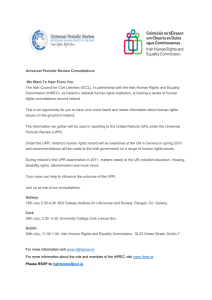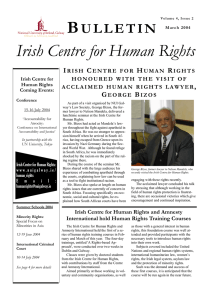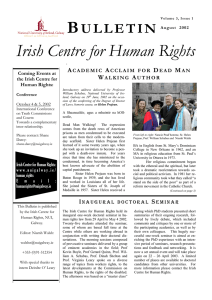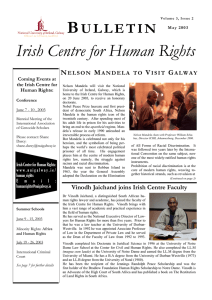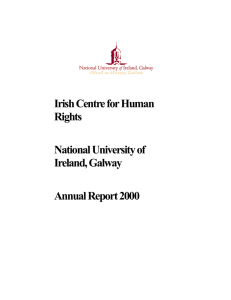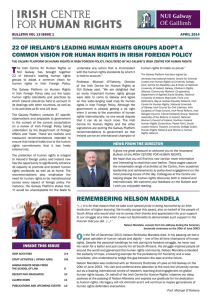Competitiveness and Creativity: The Irish / Regional Context Dr. Patrick Collins (CISC)
advertisement
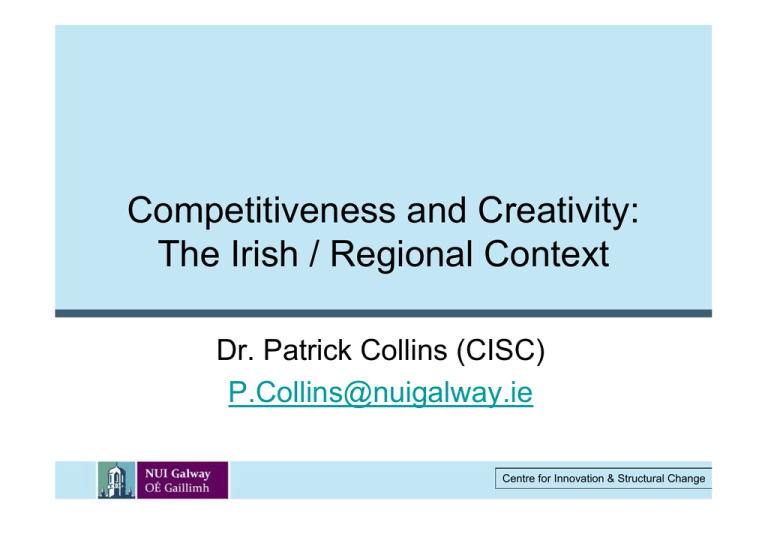
Competitiveness and Creativity: The Irish / Regional Context Dr. Patrick Collins (CISC) P.Collins@nuigalway.ie Centre for Innovation & Structural Change Theoretical grounding 2. 1. Globalisation Creative cluster in a rural region Regionalisation/ Clustering Cultural / Creativity Galway a Creative/Cultural City? 3. Centre for Innovation & Structural Change Globalisation • Coinciding factors • Technological advances • Changes in organisational structures • Policy changes • The most globalized companies become key actors whose strategies will increasingly determine the possibilities for the development of certain regions • “The meaning of place is becoming defined within the hyperspace of global corporate activity” (Amin, 2002). Centre for Innovation & Structural Change Regionalisation and Clustering • Regions as the places to convene and capitalise on Knowledge flows (Storper). • Ireland’s success over the Celtic tiger experience – Dublin’s success? • Contradiction? Medium and long term development of regional economic areas is dependent on a combination of regional and global ties. • Silicon Valley remains Silicon Valley. • From Marshall to Perroux to Porter. • The testable hypothesis: If there is a close network between companies and institutions in a certain region, the competitiveness and economic development of this region will be promoted. Centre for Innovation & Structural Change Culture and Creativity • “Most people encounter Ireland today through culture: whether that is Irish dance and music, Irish film, Irish writing or an Irish play on Broadway” (Irish Taoiseach) • Its about quality of life as much as anything else. Its vibrant and diverse, that will continue to attract people. • The three ‘Gs’ – Guinness, Golf and Good craic. • “We know everyone with Irish connections on the Board”. Diaspora. • More tourists per cm of rainfall • Tony, Academy, Golden Globes, Mann Booker • Move towards appreciating Symbolic knowledge over the importing of analytic and synthetic Creative Industries • The creative industries have been cited as having economic and social benefits to local contexts (Fleming, 1999; Myerscough, 1988), as a significant source of export earnings (Griffiths and Williams, 1992), as often being used in locational marketing (Landry, 1995), and as a vital element of integrated urban and regional regeneration strategies (Evans, 2001; Florida, 2002; O'Connor and Wynne, 1996; Parkinson and Bianchini, 1996). • Spatial agglomerations of creative industries are considered to be key elements in the movement from Fordism to post-Fordism, and were seen as central to the economic and symbolic competitiveness of national economies and city-regions and their ability to compete in a globalised `knowledge economy' (Florida, 2002; Scott, 2004). Centre for Innovation & Structural Change Centre for Innovation & Structural Change Creative West – WDC report (February 2009) • • • • • • 4,779 creative businesses Direct employment 11,000 (3%) Annual turnover = €535m Direct GVA = €270m Indirect employment = 3,800 (serv) Indirect GVA = €300m • • 1 in 33 jobs compares: London, 1 in 7; NZ 1 in28 West: 1 in 20 in public admin; 1 in 15 in hotels and restaurants Centre for Innovation & Structural Change Dublin Geographic Distribution of TV and Film Production Companies in Ireland (SPI) Centre for Innovation & Structural Change Indreabhán Cluster • • • • • • N = 28 Employing 300 fulltime and up to 400 part time (Main employer of the micro region) Larger and older than national average Different focus – Documentary making and Animation are the main focus (also dubbing) International recognition. Nearly two thirds are selling their product internationally – showing a change from dependence on TG4 Over half of companies had staff training in past 2 years. • • • “You guys are closer to us that XXXX in Burbank (Hollywood)” Decentralisation “You ask people, and they will tell you the real Digital Hub is 15 miles west of Galway”. Emergence of a cluster of significance and competence in Documentary making and Animation. Clustering “Culture is important to the people of Galway, the language is important to these guys, its and us versus them (Dublin) scenario a lot of the time. We aren’t going anywhere” Rise of the creative class - embeddedness Centre for Innovation & Structural Change Galway a Creative City? • Young, well educated, diverse, services oriented, vibrant arts scene etc. Centre for Innovation & Structural Change Carefully constructed image… Harmonious Mix • 100+ ‘Hi-tech’ Companies in a city of 80,000 • Activities ranging from wireless solutions to web design to data-processing • Though not available at a city level, companies involved in R&D are at or above the national average Areas of Activity Ow nership 18% 31% Software/Development 38% 11% Indigenous MNC 69% Solutions Services Data Processing Consulting 13% 20% Other Centre for Innovation & Structural Change All facets cited by business leaders in Galway • “The city has a quality of life second to none, when our CEO asked how we would be able to maintain a workforce of 500 from such a small city we persuaded him that we would have no problem attracting people here from the whole western seaboard with a population of over 500,000. When he came here to open the plant, he agreed” (Company Representative USowned MNC - Interview September 2008). Centre for Innovation & Structural Change Contested ownership • “You pick up the paper and there are jobs advertised by them [large multinational based in Galway] and half of their ad is a picture of our work, so you see our work being used by them to market themselves, yet we see no money for that” • “Oh to be sure it’s a cultural capital… so long as you are here for the right three weeks of the year!” • 1.5% of city re-development allocated to creative spaces • Contested ‘ownership of culture’. Lack of coherency in the city’s cultural development. Buyer Beware! • Creative city strategies are predicated on, and designed for, a neoliberal terrain. We are repackaging urban cultural artefacts are competitive assets (valued in terms of economic utility!). • Enabling the commodification of space (Latin Quarter) and the endless rehashing of urban vistas along ‘successful’ lines (‘guggenheiming’). • Ease of adoption of the Creative Industries mantra panacea • Potentially we could be uncovering something that Ireland has a competitive and comparative advantage in. • A new indigenous innovation model combining the unique strengths of Irishness. • Space transcendence – we could be looking at more spatially diffuse development. • Global and the local mix in right proportions. • Place of Policy? Centre for Innovation & Structural Change • Thank you • P.Collins@nuigalway.ie • http://www.nuigalway.ie/cisc/people/pcolli ns.html • www.nuigalway.ie/cisc Working Paper series.

